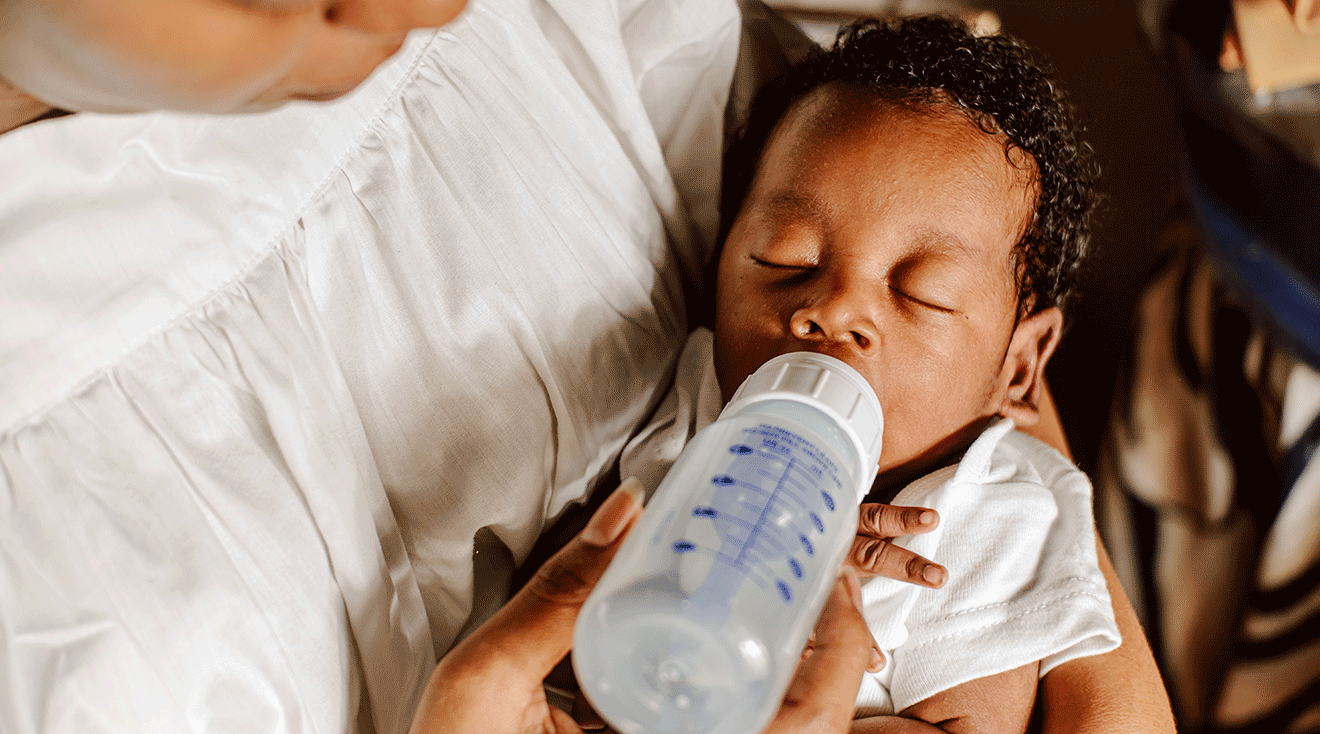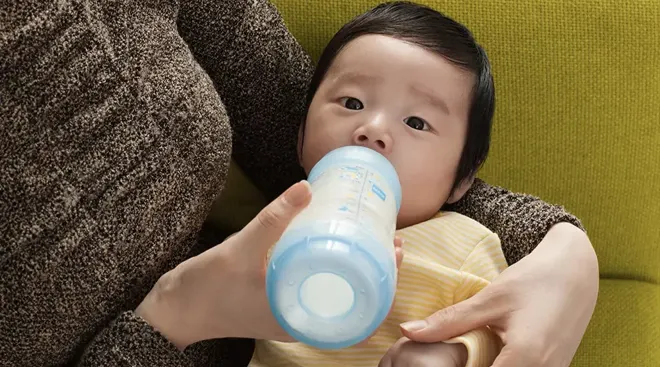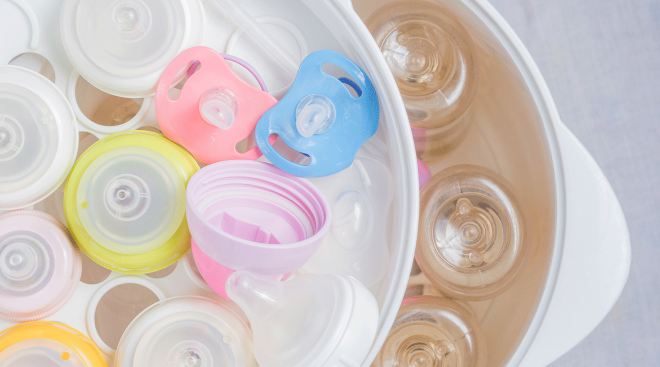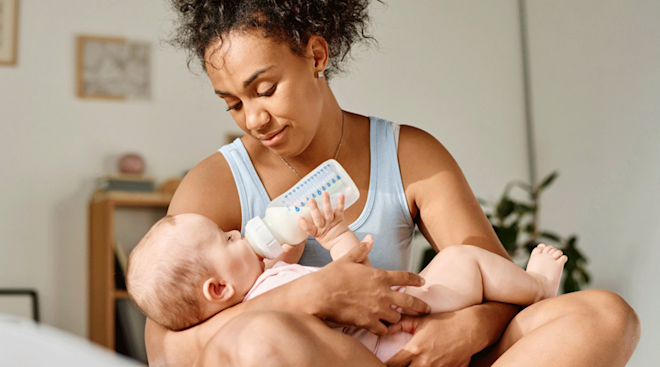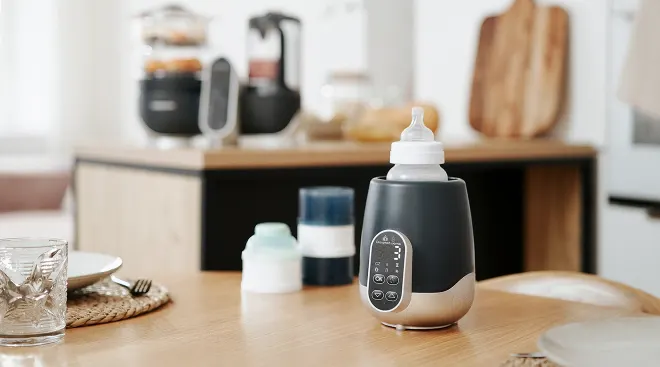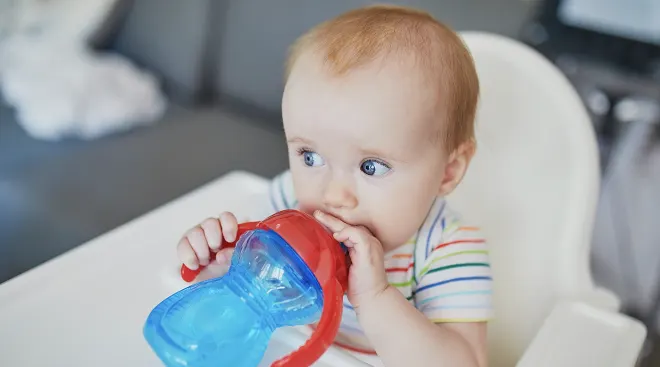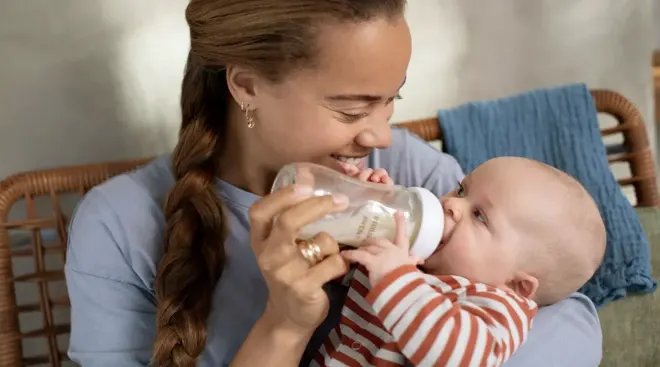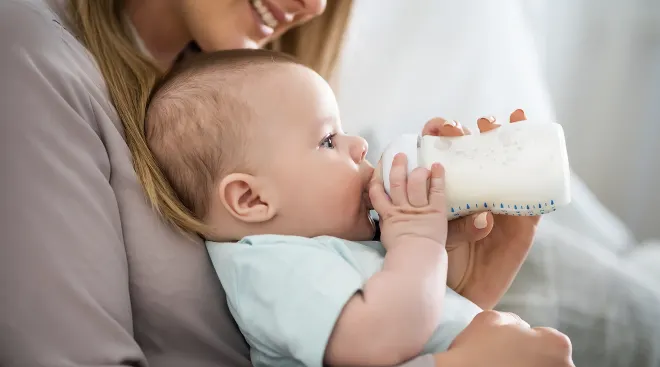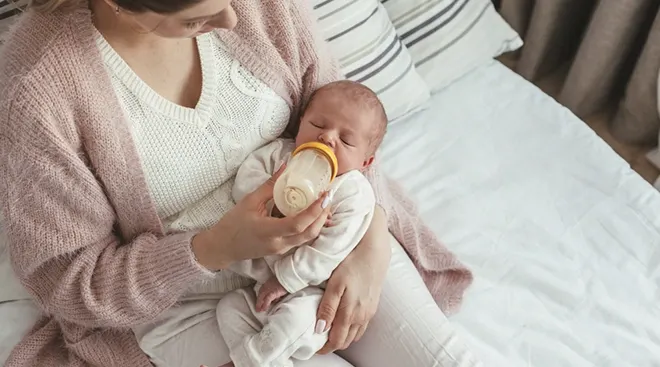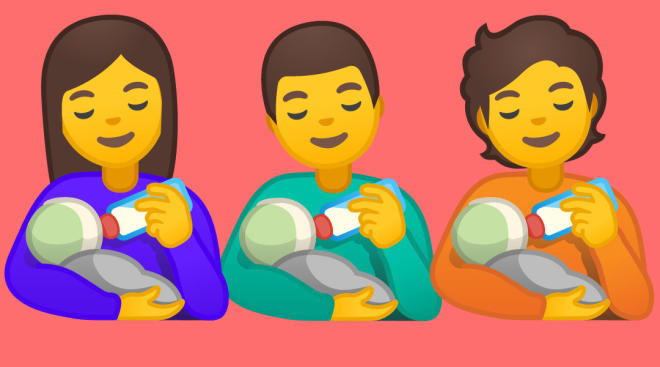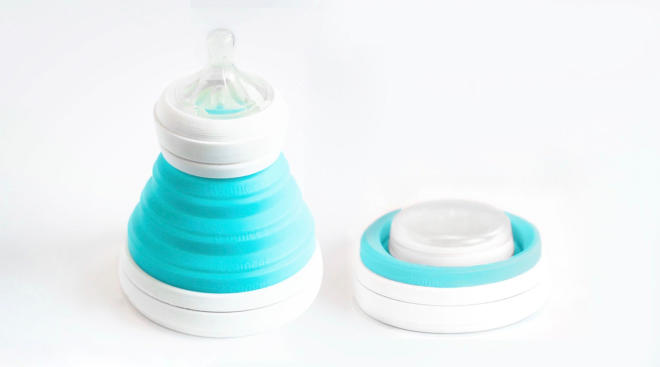The Benefits of Paced Bottle Feeding
You want to make sure that baby is getting enough to eat and gaining weight at a healthy rate. But until you and your little one get a feel for this whole bottle feeding thing, it can take a minute to truly grasp their needs. That’s where paced bottle feeding comes in. It helps both of you find and keep a rhythm during each feeding session and can ensure that baby doesn’t eat too much (or too little). Better yet, it can stave off tummy troubles. Ready to learn more about this paced bottle feeding technique? Read on for the full 411.
Paced bottle feeding is an intuitive, baby-led approach that closely follows your little one’s feeding cues. Essentially, the method mimics the way babies naturally feed at the breast and lets them control the pace of their feed, explains Cuyler Romeo, IBCLC, a pediatric feeding specialist and director of strategic initiatives at Feeding Matters. Paced bottle feeding uses a bottle to similarly achieve the rhythm and intimacy of breastfeeding and is customized to baby’s needs at each feed. “The caregiver periodically stops the flow of milk by tipping the bottle down so the infant can take a short break to breathe or rest,” Romeo says. “This gives the infant more control over when they want to accept milk and how much they want to suck at a time.”
Eventually, when baby seems full (i.e. they stop sucking, turn their head away, seem sleepy, lose their latch, become more relaxed, etc.), caregivers can end the feeding—and this may also help prevent overfeeding. In fact, one of the best parts about the paced bottle feeding technique is it takes the guesswork out of a traditional bottle feed. Baby will tell you when they’re hungry and when it’s time to stop.
Paced bottle feeding is all about reading baby’s feeding cues—but exactly how can you get started with your newborn? First, you’ll want to use a bottle with a tapered nipple and slow flow—the slowest possible when feeding a newborn, says Shiri Perl, LPN, IBCLC, lactation consultant and founder of Best Latch. She also suggests teaching all of baby’s caregivers (i.e. parents, grandparents and daycare staff) how to use the paced bottle feeding method to ensure consistency in baby’s feedings.
Below, Romeo offers a step-by-step guide on how to practice the paced bottle feeding technique:
- Hold your baby in a fully supported upright or elevated side lying position.
- Gently stroke the side of baby’s mouth or lip with the bottle nipple to encourage them to open their mouth. Watch for signs baby is ready to feed, such as rooting or turning towards the nipple.
- Instead of tipping the bottle downward into baby’s mouth as you would for a traditional bottle feed, hold it in a level horizontal position to encourage active sucking in response to the milk flow. If baby is too far reclined, gravity will make the flow of the bottle too fast. Tip: Make sure the nipple is always full of milk so baby doesn’t take in too much air.
- Pause often, as most infants need to stop sucking to recover their breathing. If baby’s eyes widen, they pull away from the nipple, milk leaks from the corners of their mouth or you hear gulping sounds, they could be telling you they need a break.
- Tip the bottle down to stop the flow of milk into the nipple or remove the nipple completely to provide a short break.
- When you’ve finished, keep baby in an upright position for about five to 10 minutes and don’t forget to burp them to reduce gas.
Per La Leche League International, it should take baby around 15 to 20 minutes to finish the bottle. Throughout the feed, remember to watch baby closely and follow their lead.
“Burp [baby] if they show signs of discomfort, give them a break if they get sleepy and start and stop the feeding when they show signs of being full or hungry for more,” advises Romeo.
When bottle feeding baby, it’s tempting to make sure they empty their bottle. After all, we all want to make sure our children are well nourished and take in enough milk. But research suggests that responsive feeding–at the breast or bottle–can actually be more beneficial for long-term, healthy weight gain. That’s why paced bottle feeding is often recommended by healthcare providers. While a breastfed baby is likely to self-regulate their milk intake and achieve healthy rates of weight gain, a bottle-fed baby doesn’t have the same control, notes Alison K. Ventura, PhD, LEC, FTOS, professor of kinesiology and public health at California Polytechnic State University.
The traditional features of bottles make feeding easy, but can override infant hunger and fullness cues, and increase the pace of feeding, ultimately lead to overfeeding. Paced bottle feeding encourages you to slow the rate of feeding, allowing your little one to sense fullness and moderate their intake themselves.
Moreover, because babies are born with small stomachs and immature gastrointestinal tracts, paced bottle feeding can also aid digestion and reduce gas, adds Sarah Peck, RN, MSN, IBCLC, a registered nurse, lactation consultant and owner of Nesting Lactation.
Frequently Asked Questions
What’s the best bottle for paced bottle feeding?
Although bottle selection can be highly personal, the key to paced bottle feeding is the slow flow nipple. It may also be helpful to look for a bottle that allows you to fill the nipple with milk without dripping when held level, suggests Romeo. She warns that some wide base or less graduated nipples need to be tipped more than others to bring milk into the tip of the nipple. “This may make it more difficult to feed the baby in an elevated position with a horizontal bottle,” she says.
Does baby swallow more air with paced bottle feeding?
A common concern with paced bottle feeding is that babies will take in excess air. However, with the right paced bottle feeding technique taking in more air shouldn’t be an issue. “If the caregiver is burping the infant according to cues and at the end of the feeding, additional air intake isn’t typically problematic,” Romeo says, adding, “Paced feeding brings advantages that may outweigh this concern for most infants.”
Can you practice paced bottle feeding if you’re also breastfeeding?
Most babies can benefit from the paced bottle feeding technique. Parents should introduce paced bottle feeding as soon as they introduce the bottle to breastfed babies “to help prevent flow preference (previously thought of as nipple confusion) and to help support the switch between bottle and breast.” Peck adds that breastfeeding parents should use a slow flow bottle with a wider base so baby’s working for the bottle in the same way they would at the breast. “This way we preserve that work and we don’t risk baby refusing the breast after taking a faster flow bottle,” Peck says.
At what age should you stop practicing paced bottle feeding?
Once baby can hold their own bottle and control their milk intake, you can consider relaxing your approach, says Perl. This typically happens once baby is around 8 to 10 months old.
Welcoming a newborn will inevitably present some curveballs—and that’s ok (and to be expected!). In some cases, baby may have special feeding needs that require a different approach, so always reach out to your provider for specific questions and concerns.
You’ll likely experiment with a variety of different feeding methods before settling on a technique that’s comfortable for you and baby. Whatever you decide, the key is finding an approach that helps baby continue to gain weight at a healthy rate and develop good eating habits.
Please note: The Bump and the materials and information it contains are not intended to, and do not constitute, medical or other health advice or diagnosis and should not be used as such. You should always consult with a qualified physician or health professional about your specific circumstances.
Plus, more from The Bump:
Sarah Peck, RN, MSN, IBCLC, is a Los-Angeles-based registered nurse, lactation consultant and owner of Nesting Lactation. She earned her master’s of science in nursing from University of Illinois and completed her IBCLC training at University of California San Diego.
Shiri Perl, LPN, IBCLC, is a board certified lactation consultant, postpartum doula and pediatric nurse with over a decade of experience. She’s also the founder and CEO of Best Latch, a consultation platform that provides care and resources to new parents.
Cuyler Romeo, IBCLC, is a pediatric feeding specialist, treating clinician with Banner-University Medical Center’s NICU and director of strategic initiatives at Feeding Matters. She earned her master’s degree in occupational therapy from the University of Texas Health and her certification in lactation counseling from Healthy Children Project Center for Breastfeeding.
Alison K. Ventura, PhD, LEC, FTOS, is professor of kinesiology and public health at California Polytechnic State University. She earned her master’s degrees and doctorate in nutrition and human development from Pennsylvania State University.
La Leche League International, Breastfeeding Info Bottles and Other Tools, January 2019
Journal of Nutrition Education and Behavior, Knowledge and Use of Paced Bottle-Feeding Among Mothers of Young Infants, September 2023
Learn how we ensure the accuracy of our content through our editorial and medical review process.
Navigate forward to interact with the calendar and select a date. Press the question mark key to get the keyboard shortcuts for changing dates.
































